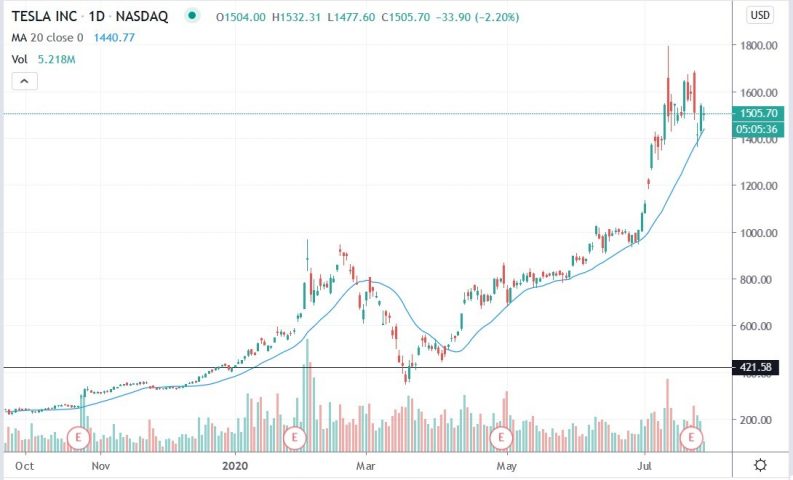If you know anything about trading, you may have heard the saying ‘Buy Low, Sell High'. Short-selling is the antithesis of this approach, with short-sellers aiming to ‘Sell High, Buy Low' and profit from a price drop. Shorting a stock isn't for the faint-hearted; it's a high-risk/reward trading strategy with the potential for unlimited losses if you get it wrong.
In this guide, you will learn:
- What short selling is
- How it works
- The advantages & disadvantages
- How to short a stock (step-by-step)
What Is Short Selling?
Short selling stocks is the process by which an investor borrows a stock and then sells it intending to repurchase it at a lower price in future, hence making a profit. The short seller has to return the shares to the lender after buying them back.
‘Shorting', whilst not overly complicated, is considered an advanced trading/investing strategy unsuitable for beginner traders, largely due to the leverage usually involved. Modern online trading platforms have the functionality to support short-selling, which means retail traders are beginning to be able to take part in an activity which was for a long time reserved for the big guys, like hedge funds.
Short selling is a risky strategy because the investor losses money whenever the price of the stock they are shorting goes up. Historically, stock prices usually tend to rise over time and could keep rising to infinity, exposing the investor to unlimited losses. However, the reward for short-selling is fixed because the stock can only fall back to zero. That said, markets tend to move up gradually over a long period, but crashes can occur in weeks or days. Once momentum points downward, panic can sweep the markets meaning short-selling strategies, when timed right, can make significant returns in a short time.
How Short Selling Works
Short selling involves borrowing a stock from someone who owns it, which in most cases is your broker, and then selling it to another person. This process is known as ‘selling to open' because you are opening a new position by selling the stock instead of buying it. Your broker will require you to set aside some funds to back your position, which is known as margin.
Therefore, you need a margin account to short stocks due to the risks associated with the strategy. Once you have sold the borrowed shares, you will receive a credit in your account equal to the price paid by the buyer. You only make money on the trade if the stock's price keeps falling, and you lose money as the price rises.
You do not have to worry about finding someone whose shares you can borrow, as the broker handles that part of the transaction. The broker could even buy the shares and lend them to you for your short trade so long as you have sufficient margin in your account. In some instances, certain unpopular stocks might be shorted to the extent that your broker cannot find stock to borrow to facilitate your short position. In this instance, the trading dashboard will take care of things and will not allow you to open a new short position.
Advantages of Short Selling
The main advantage associated with short selling is that a trader can use this strategy to protect their portfolio from future losses. For example, an investor who owns stock in XYZ company and is sitting on decent profits accrued over several months may feel that the stock is likely to sell off after an upcoming earnings report. The investor could initiate a short trade to profit from the potential decline without selling their current holdings.
If the trader uses margin to fund the trade and leverage up on position size, which most short-sellers do, then they stand to make a significant profit if they make the right call. This also reduces the frictional costs of buying and selling positions in a long-only portfolio.

Disadvantages of Short Selling
The main disadvantage of short selling is that the potential gains from this strategy are limited, while the potential losses are unlimited. That goes against the basic principles of successful investing and trading, which are built around minimising risks while expanding one's profit potential. We discuss a real example of short selling going wrong further within the article.
Short selling tends to be capital intensive. It could tie up your investment capital for years before bearing fruit, as evidenced by the biggest short-selling trades in history. For example, hedge fund managers who shorted the housing market made huge profits when the subprime mortgage crisis hit in 2008, but that trade was non-profit-making from day one. As those short positions posted unrealised losses, the traders were left facing the decision of whether to cut their position and crystalise their losses or trust their analysis.
The fluctuations in P&L are only part of the story. The capital used to collateralise those short positions could be used on other, potentially more profitable trades in different asset groups. Every trade has an opportunity cost, but given the risks associated with short selling, brokers tend to apply high margin rates on short positions.
There are also financing costs to consider. When short selling, you have to pay interest on the margin provided by the broker since you've effectively loaned the shares. You could also be subject to margin calls if the stock's price rises above the margin requirement for the position, usually 25%. Therefore, if the stock rallies and your margin falls below 25%, you must add funds to your account to reach the required limit or be forced to liquidate your position.
One of the most significant risks associated with short selling is a short squeeze. This occurs when stock prices start rising, forcing short sellers to buy back their shares to cover their positions. The buying frenzy causes the stock's price to keep rising, attracting more buyers and forcing more short sellers to cover their positions. This usually becomes a self-fulfilling loop that could last for a while, causing short sellers to incur massive losses over a short period.
A common mistake beginner traders make is to think that ‘the market has got to turn at some point'. Studies have looked at this deep-seated phenomenon, and those who become successful traders are often the ones who learn to trade with the trend, not against it.
Historical data points to stock markets tending to Even after the sharp sell-off in the stock markets seen in 2022. The S&P 500, the FTSE 100 and most other global stock indices are still trading at higher prices today than they did say five years ago. Only on rare occasions when we get a recession and a bear market will most stocks head lower. Therefore, most short-sellers are usually going against the trend when shorting a stock, which increases the chances that they could be proven wrong.
Timing Issues and Regulatory Risks
Given that short sellers are usually betting against the trend, it is not surprising their bets sometimes work against them because they enter into trades too early. Most short trades take time to work out because of this fact, and given the interest payments and margin requirements, it is expensive to hold short trades for long periods.
Regulators may also decide to halt the shorting of particular stocks if their prices fall beyond a certain threshold over a short period, such as a trading session. This could force the stock's price to rise due to the low supply conditions created by the short-selling ban. Those in existing short positions quickly grasp the signal being sent out by the regulators. Instead of continuing to fight with one hand tied behind their back, they join the ranks of buyers, close out their positions, and the stock price rises.
Shorting Stocks With Options
Investors can also simulate shorting a stock using Put and Call options to create a synthetic short position. A Put option gives its holder the right, but not the obligation, to sell the underlying security at the specified price within the specified period.
A Call option gives its holder the right, but not the obligation, to buy the underlying security at the specified price within the specified time. Naturally, the prices of options contracts are directly impacted by the underlying security price.
If shorting a stock with options, an investor usually buys a Put option. By doing so, the Put option will increase in value if the stock price falls. However, simulating a short position using options carries certain limitations since options have expiration dates.
Once an option expires, the investor has to either meet the obligations of the options contract or close out his position. Those time limits don't exist when shorting a stock in the traditional way.
Short Selling Example (Gone Wrong)
There are many disadvantages associated with short selling, chief among them being that a stock's price could rise to infinity while it could only fall back to zero. A good case of short selling gone wrong is Tesla's rally in 2020, as illustrated in the chart below.

You can see that Tesla rallied from $421 at the start of the year, marked by the black line, to a high of $1,505 at the time of writing. People who were short Tesla stock at the start of the year have lost about $1,100 per share, yet their max gain was just $421. That is precisely what we mean when we say that a company's share price can rise to infinity, but it can only fall to zero.
The short-sellers stand to lose way more if Tesla's stock rallies higher, which we can never rule out given that companies such as Berkshire Hathaway trade above $280,000. Tesla's future gains are unlimited, whereas its losses are limited to its current share price. Hence, a short seller's gains are limited, while his losses are potentially unlimited.
When Short-Selling Makes Sense
Short selling only makes sense in rare situations where the odds of a company's stock price falling are high, such as when it is in substantial financial trouble or when the investor has discovered significant flaws with a firm's business model, such as illegal business practices. However, markets do not always operate efficiently. It may take a long time for other investors to realise the same stock is overvalued, which means that short-sellers can be ‘right' but still lose on a trade.
Best Times to Short a Stock
The best time to short a stock is near its highs when the price is highly overextended, and there is a negative trigger. You should have studied the stock for a while before shorting it to identify when it is overvalued, and there is likely to be a negative trigger such as a missed debt payment. Shorting the stock ahead of a negative trigger increases the chances of the trade working in your favour.

Short-Selling Tips
- The key to success as a short seller is to study the company you are about to short.
- Ensure you understand its fundamentals, including products, revenues and business model.
- Also, study its technicals by looking at the price action over the long term, say a few years and then extrapolating to the present.
- Look for a negative fundamental trigger that could get the price rolling over to the downside.
- Lastly, ensure that the current price is ideal; that is, it's over-extended before initiating your short trade.













